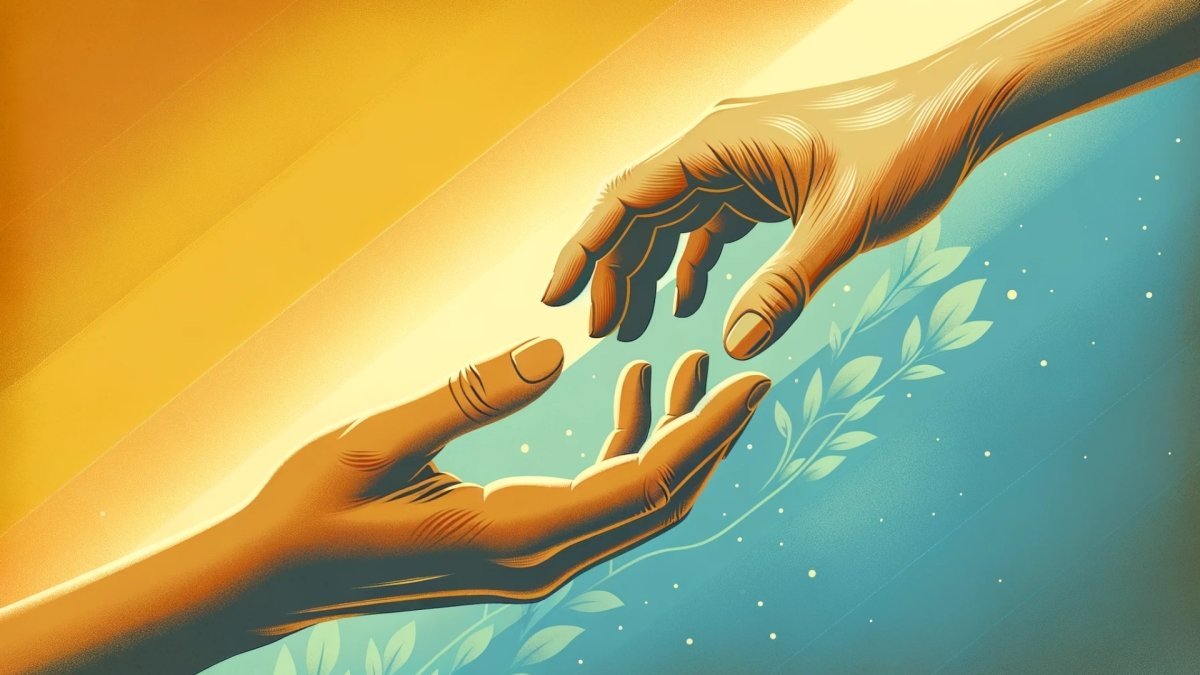
Relationships are a Two-Way Street: The Give and Take of Love
Table of Contents
Key Takeaways
- Reciprocal relationships are fundamental to personal and social well-being, requiring mutual effort and exchange.
- Effective communication and understanding are the cornerstones of maintaining balance in any partnership.
- Personal growth should be aligned with relationship evolution to ensure both individuals and their relationships flourish.
"Life's boomerang effect; what you give, you get" - Bayu Prihandito
This concept, is similar to the fundamental law of Newton's motion—every action has an equal and opposite reaction—serves as a cornerstone in human interactions. Reciprocal relationships are built on a foundation of mutual exchange where the feelings, efforts, and support are shared between individuals, creating a balanced and harmonious connection.
Whether it's in friendships, family, romantic partnerships, or at work, the principle of reciprocity acts as the unwritten contract that sustains and nourishes these bonds. By embracing this fundamental aspect of human connection, we set the stage for a symbiotic relationship where both parties flourish.
The Essence of Reciprocity in Relationships
Understanding the 'Two Way Street' Metaphor
When it comes to personal connections, grasping the 'Two Way Street' metaphor is fundamental to appreciating the essence of reciprocity in relationships. This analogy illustrates the balanced give-and-take dynamic vital for nurturing healthy, authentic relationships. Much like how traffic adheres to street boundaries to maintain flow, relationships flourish when each person invests effort, fostering a sense of fairness and equality that bolsters the relationship's balance and longevity.
The Psychological Foundations of Mutual Exchange

The psychological foundations of mutual exchange in relationships are deeply rooted in our evolutionary history. Our innate drive for reciprocal interactions extends beyond transactional exchanges—it's woven into the fabric of our social being. People's wanting for two-way communication and cooperation is a trait that has propelled our species forward, highlighting the significance of mutual exchange in relationships gratitude and growth.
Examining through the prism of social psychology, two-sided relationships address our intrinsic desires for connection and validation. Engaging in a two-way relationship dynamic transcends physical exchanges; it's a testament to our need for emotional reciprocity and interpersonal harmony. This cycle of reciprocal support and validation not only strengthens individual bonds but also weaves a stronger community fabric, enhancing our collective resilience and sense of belonging.
Navigating Life Together: The Dynamics of Partnership

In the journey of life, the dynamics of a partnership, whether platonic, romantic, or professional, are fortified by the principles of reciprocity and mutual respect. The delicate balance of giving and receiving, alongside open and transparent communication, creates an environment where individuals can thrive both independently and jointly.
Balancing Give and Take
The art of balancing give and take in personal relationships is akin to a dance, where partners move in synchrony, aware of each other's rhythm and pace. It's a dynamic interplay that requires attentiveness and the willingness to adapt. Here are key aspects that contribute to this balance:
- Equitable Exchange: Ensuring that both parties feel their contributions and gains are fair and balanced.
- Emotional Accounting: Keeping an informal 'ledger' of emotional investments made and the returns they yield in joy, support, and fulfillment.
- Mutual Support: Offering support not as a transaction, but as an organic expression of the relationship's strength.
Incorporating these elements into the framework of a relationship allows for a healthy ebb and flow of give and take, preventing feelings of resentment or one-sidedness.
The Role of Communication

At the core of a two-way relationship lies communication, serving as both the bridge and the buffer in the partnership. Effective communication encompasses several layers:
- Expressive Clarity: Articulating thoughts and feelings in a way that is clear and understandable to the other person.
- Active Listening: Engaging with what is being communicated, demonstrating understanding and empathy.
- Feedback Mechanisms: Providing and receiving feedback that is constructive and aimed at strengthening the relationship.
By prioritizing communication, partners create a dialogue that goes beyond mere words, encompassing non-verbal cues, emotional exchanges, and the unspoken understanding that often develops over time. This dialogue is the heartbeat of a two-way relationship, sustaining and nurturing the partnership through the inevitable challenges and triumphs of shared experiences.
What a One Way Relationship is?
Relationships may occasionally move into a one-way street, where the equilibrium of reciprocity is disrupted, and the scales tip in favor of one party. This can be challenging for both partners, often leading to feelings of discontent and underappreciation. Recognizing the signs of this imbalance is crucial for the health and longevity of the relationship.
Recognizing Unbalanced Efforts and What to Do
- A disproportionate amount of effort from one person.
- Lack of acknowledgment for contributions and sacrifices.
- One partner's needs and desires consistently taking precedence.
To redirect the relationship back to a two-way street, consider the following strategies:
- Open Dialogue: Initiate conversations about the perceived imbalance without accusations or defensiveness.
- Set Boundaries: Clearly define personal boundaries that foster respect and prevent overextension.
- Realign Expectations: Adjust expectations to a realistic level where both partners can contribute equally.
| Strategy | Action | Expected Outcome |
|---|---|---|
| Open Dialogue | Share feelings and listen actively | Mutual understanding |
| Set Boundaries | Define what is acceptable | Respect and self-care |
| Realign Expectations | Understand and agree on what is feasible | Balanced contributions |
Intersection of Personal Work & People Living Together
The journey of personal growth and the evolution of shared lives are deeply intertwined. As individuals grow, so should the relationships they are part of. This growth can either harmonize with the partnership or create discord if not navigated thoughtfully.
Cultivating a Relationship That Grows with You
To maintain a relationship that grows in tandem with personal development:
- Shared Goals: Establish common objectives that resonate with both partners' aspirations.
- Supportive Autonomy: Encourage and support each other's individual pursuits while maintaining a connected partnership.
- Adaptive Dynamics: Remain open to changing roles and responsibilities within the relationship as both individuals evolve.
Embracing personal change within a shared life requires a delicate balance, where both parties must be committed to their own growth as well as the growth of the relationship.
- Evolution of Interests: As interests evolve, introducing each other to new hobbies and experiences can enrich the relationship.
- Communication Upgrade: As individuals grow, so must the way they communicate, ensuring that it matures to reflect their changing selves.
By creating an environment where individuality and togetherness coexist, partners can celebrate personal milestones while building a shared narrative that is rich and multifaceted.
The Road Signs of a Healthy Relationship

Identifying the markers of a thriving two-way relationship is like recognizing the road signs that guide you on a journey through life. These indicators are essential in navigating the complexities of connection and ensuring that both people in the relationship are contributing equally, moving in harmony towards shared goals.
- Boundaries are the personal limits that protect each person’s sense of self within the relationship, fostering mutual respect and safeguarding against one-way street dynamics. They are pivotal for maintaining individuality, essential for recovery from issues, and preventing resentment in both personal and business relationships.
- Expectations in a two-way relationship should be clear, realistic, and communicated often, acting as a roadmap for the partnership’s growth. They help align individual roles and contributions, preventing miscommunications and disappointments that can lead to issues like divorce.
- Appreciation, akin to two-way communication, is the fuel that keeps the relationship engine running smoothly. Consistently expressing gratitude for each other’s efforts reinforces the value of both partners and the authenticity of the relationship itself.
By integrating these elements, the relationship evolves into a balanced two-way street, where mutual exchange, respect, and gratitude form the cornerstones of an enduring and authentic connection. It becomes a partnership where both sides contribute to the creation of a world filled with understanding, friendship, and love, avoiding the pitfalls of a one-sided connection.
Final Thoughts
In this blog, we've navigated the intricate pathways of reciprocal relationships, understanding their core principles and how they influence our lives. The insights shared here aim to guide you towards fostering healthier, more balanced connections with those around you.
At Life Architekture we offer personalized strategies to help you build and maintain these meaningful relationships. Our coaching is designed to support personal growth and partnership development, ensuring that as you evolve, so too does the harmony in your relationships.
Frequently Asked Questions
What is the basis of a reciprocal relationship?
A reciprocal relationship is based on the principle of mutual exchange where each person's contributions and benefits are balanced, fostering mutual respect and satisfaction.
How can communication improve relationships?
Open and honest communication allows for the expression of needs and expectations, leading to a better understanding and stronger, more connected relationships.
What are signs of an unbalanced relationship?
Signs include feeling consistently undervalued, a lack of mutual effort, and one person consistently giving more than they receive.
How does personal growth affect relationships?
Personal growth can either strengthen a relationship if both partners grow together or create a distance if they grow apart. It's crucial to align individual development with the relationship's growth.
What steps can be taken to maintain a healthy relationship?
Maintaining a healthy relationship involves setting clear boundaries, having equitable give and take, and fostering appreciation and gratitude towards each other.









